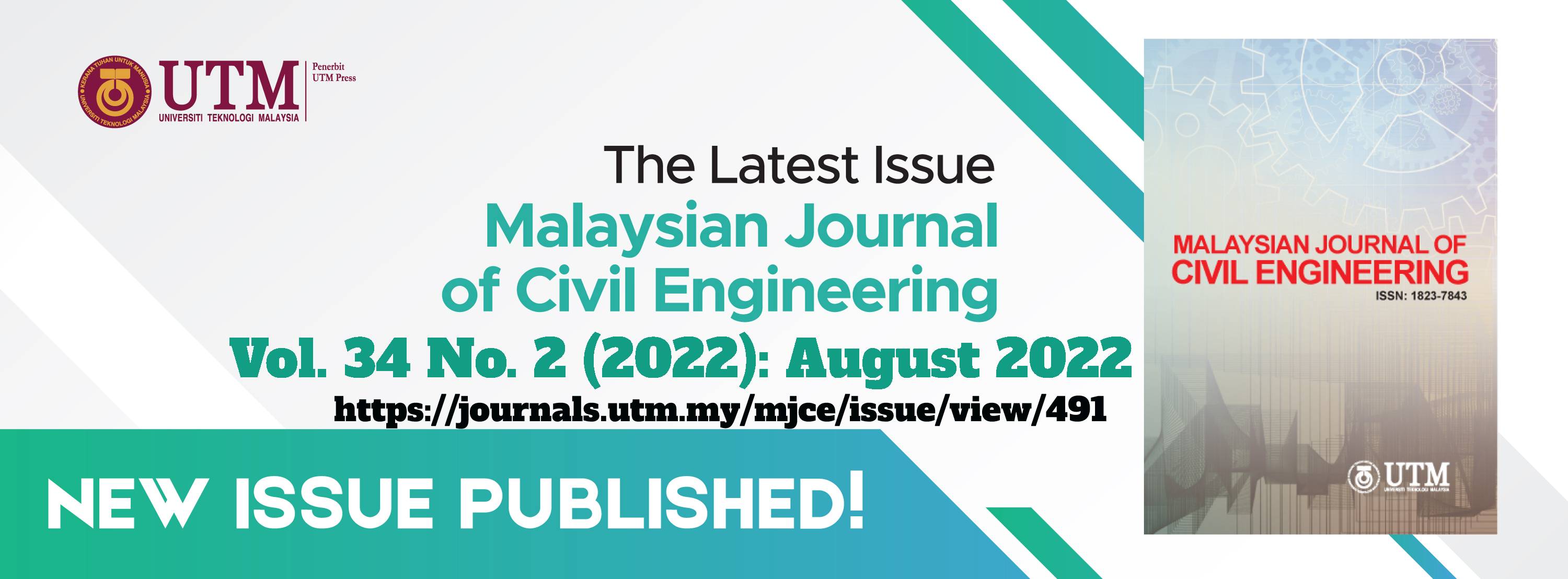PERFORMANCE EVALUATION OF THE HYBRID GEOBAGS AND PU FLATBED SYSTEM AS A SOFT GROUND IMPROVEMENT WORK
DOI:
https://doi.org/10.11113/mjce.v34.18612Keywords:
Geobag, PU flatbed, Soft ground, Consolidation settlement, PLAXISAbstract
Soft ground is commonly known as a problematic soil foundation, thus required a ground improvement work to be executed. research was carried out to evaluate the performance of the Hybrid Geobag PU flatbed as a proposed remedial work for the failed embankment founded on soft ground in Pulau Betong. Back-analysis of existing embankment was executed using PLAXIS 2D in order to investigate the failure mechanism of the existing embankment. The cause of the embankment failure is due to the excessive consolidation settlement which causes both vertical and horizontal displacements of the . Performance of the proposed remedial works was compared with the conventional design solution of bored pile embankment. Existing embankment has an extreme vertical displacement of 1.87m and horizontal displacement of 0.259m. With the Hybrid Geobag PU flatbed method, the vertical and horizontal displacement reduced to 0.879m and 0.098m respectively. The vertical and horizontal displacement further reduced to 0.099m and 0.030m respectively with bored pile method.
References
Agrawal, B.J. 2011. Geotextile: It’s application to civil engineering–overview. In Proceedings of the National Conference on Recent Trends in Engineering & Technology, Anand, India, 13–14: 1–6
Balasubramaniam, A. S., Cai, H., Zhu, D., Surarak, C., and Oh, E. Y. N. 2010. Settlements of embankments in soft soils. Geotechnical Engineering, 41(2): 0046-5828
Benjamim, C.V., Bueno, B.S. and Zornberg, J.G. Field monitoring evaluation of geotextile-reinforced soil-retaining walls. Geosynthetics International. 14: 100–118.
Faheem, H., & Hassan, A. M. 2014. 2D Plaxis Finite Element Modeling of Asphalt-Concrete Pavement Reinforced With Geogrid. JES. Journal of Engineering Sciences, 42(6): 1336–1348. https://doi.org/10.21608/jesaun.2014.115106
Fibromat, 2021. Geotextile sand containers / Bags designed for coastal, river and slope protection Geotextile Sand Containers.https://www.fibromat.com.my/product/geobags/. Retrieve Date: 18 May 2021
Jeannot, Y., and Guezo, A. 2016. Consolidation Parameters for Embankment Settlement on Soft Clay Soils in Houston Area Consolidation Parameters For Embankment Settlement On Soft Clay Soils In Houston Area. The Faculty of the Department of Civil and Environmental Engineering Cullen College. August 2007. https://doi.org/10.13140/RG.2.1.2417.6728
Koerner, R. 2016. Early background and history of geotextiles. In Geotextiles; 3–15. Elsevier: Amsterdam, The Netherlands,
Park, J.B., Park, H.S., Kim, D. 2013. Geosynthetic reinforcement of sand-mat layer above soft ground. Materials, 6: 5314–5334.
Voet, M.R.H., Nancey, A. and Vlekken, J. 2005. Geodetect: A new step for the use of Fibre Bragg Grating technology in soil engineering. In Proceedings of the 17th International Conference on Optical Fibre Sensors, Bruges, Belgium, 23–27 May .214–217.
Wang, L., Xu, S. and Qiu, J. 2020. Automatic Monitoring System in Underground Engineering Construction: Review and Prospect. Advances in Civil Engineering, 1-16. 10.1155/2020/3697253
Zhao, Y., Zhou, S., Zhao, C. and Valeo, C. 2018. The influence of geotextile type and position in a porous asphalt pavement system on Pb (II) removal from stormwater. Water 10: 1205.
















